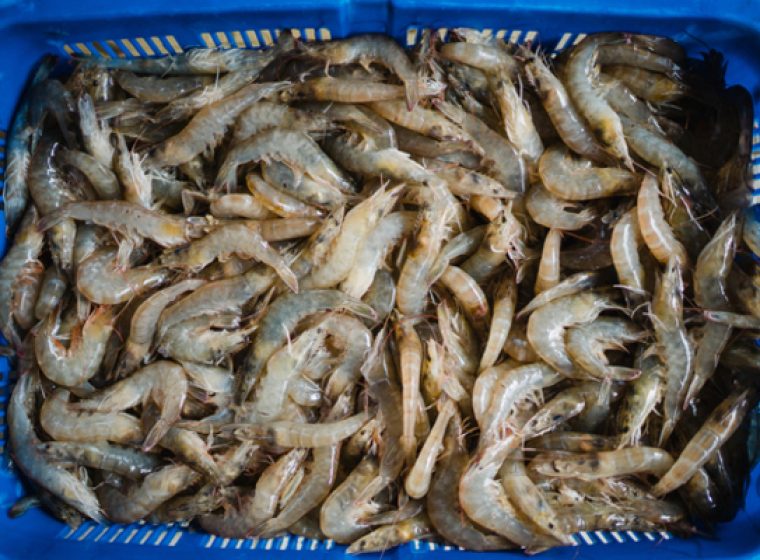Vannamei shrimp farming is a business that many people worldwide are involved in. The broad market potential makes vannamei shrimp excellent. However, disease attacks also continue to lurk during cultivation. Therefore, identify the following characteristics of healthy and diseased shrimp.
The characteristics of healthy and diseased shrimp can be seen from their physical, behavioral, and physiological indicators. Understanding these characteristics can help farmers take the following steps regarding the condition of the shrimp.
So, what are the characteristics of healthy and diseased shrimp? Read more in this article!
Also Read: Getting to Know the Taura Syndrome Virus (TSV) in Vannamei Shrimp
Characteristics of Healthy Shrimp
1. Active Swimming and Responsive
The characteristics of healthy shrimp can be seen from the level of activity. Healthy shrimp will usually actively swim around and be responsive. For example, when fed, healthy shrimp will surface.
2. Clear and Bright Colored Body
Clear and bright body color can indicate that the shrimp is in a healthy condition. Meanwhile, shrimp with shells that are dull, faded, or discolored can be an indication of a health problem.
3. Hard Body Texture
Healthy shrimp have a hard and dense body texture. There should be no mucus or body that is soft to the touch.
4. Have a Good Appetite
A good appetite for shrimp can also be an indicator of healthy shrimp. Healthy shrimp will eat regularly and eat the food that has been provided.
5. No Signs of Stress
The last characteristic of healthy shrimp is the absence of signs of stress, such as being lethargic, hiding at the bottom of the pond, and showing signs of aggression towards other shrimp.
Also Read: 5 Tips on Managing Vannamei Shrimp Ponds
Characteristics of Diseased Shrimp
1. Lethargic or Weak
The first characteristic of diseased shrimp is that they appear lazy or weak. Usually, the shrimp will move slowly or even not move at all. Diseased shrimp will tend to stay on the bottom of the pond even when being fed.
2. Has Faded Color
Diseased shrimp have discolored or faded shells. In addition, several diseases such as myo disease and white spots can also trigger discoloration of the shrimp’s body.
3. Slimy or Mushy Texture
Diseased shrimp usually have slimy or mushy bodies. This slime usually covers the entire outside of the shrimp.
4. Decreased appetite
The following characteristic of diseased shrimp is a reduced appetite for shrimp. Sick shrimp tend to have no appetite and do not eat feed regularly, so there will be lots of leftover feed in the ponds.
5. Showing Signs of Stress
Signs of stress, such as staying at the bottom of the pond or showing aggressive behavior towards other shrimp, can also be a sign of diseased shrimp.
6. Abnormal Behavior
Their abnormal behavior, such as swimming upside down or circling, can identify Diseased shrimp.
Also Read: Recognize 7 Characteristics of AHPND Disease in Vannamei Shrimp Before It’s Too Late
Consult Your Shrimp Conditions On DELOS!
Characteristics of healthy and diseased shrimp should always be a concern for farmers. Healthy shrimp are usually active, have clear and bright bodies, have a good appetite, and show no signs of stress.
Meanwhile, on the contrary, the characteristics of diseased shrimp are that the shrimp looks lethargic, the shell changes color, the body is slimy, the appetite decreases, shows signs of stress, and shows abnormal behavior.
For those of you who have shrimp that show signs of being sick, immediately carry out further tests to detect the disease suffered by the shrimp and prevent the spread of disease outbreaks.
You can consult the health condition of your shrimp on DELOS. With the best dedicated scientific team, DELOS can help you detect as well as mitigate in the event of a disease attack in your shrimp pond.
So, if your shrimp shows the characteristics of diseased shrimp as explained above, immediately contact the DELOS Team via contact@delosaqua.com or submit your pond problems in the contact column on our website at www.delosaqua.com. What are you waiting for? Immediately consult the condition of your shrimp on DELOS before it’s too late!




